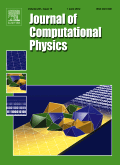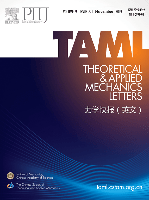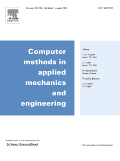
COMPUTATIONAL MECHANICS
Scope & Guideline
Unveiling New Horizons in Computational Mechanics
Introduction
Aims and Scopes
- Computational Modeling Techniques:
The journal emphasizes the development and application of computational modeling techniques, including finite element methods (FEM), boundary element methods (BEM), and mesh-free methods, to solve complex engineering problems. - Multiscale and Multiphysics Simulations:
Research published in this journal often tackles multiscale and multiphysics problems, integrating various physical phenomena such as fluid dynamics, solid mechanics, and thermal effects, to provide a comprehensive understanding of materials and structures. - Material Behavior and Constitutive Modeling:
A significant focus is placed on the modeling of material behavior, including the development of constitutive models that accurately describe the mechanical response of materials under various loading conditions, including nonlinear, time-dependent, and rate-sensitive behaviors. - Innovative Numerical Methods:
The journal features innovative numerical methods, including machine learning techniques, data-driven approaches, and advanced optimization methods, to enhance the efficiency and accuracy of computational simulations. - Applications in Engineering and Industry:
Research articles often highlight practical applications of computational mechanics in fields such as aerospace, civil engineering, biomechanics, and materials science, showcasing the relevance and impact of computational techniques in real-world scenarios.
Trending and Emerging
- Machine Learning and Data-Driven Approaches:
There is a significant increase in research integrating machine learning techniques and data-driven approaches to enhance computational modeling and predictions, reflecting the industry's move towards smart, adaptive systems. - Multiscale and Multiphasic Modeling:
The trend towards multiscale and multiphasic modeling is gaining momentum, with researchers focusing on the interactions between different scales and phases in materials, particularly in complex systems such as composites and biological materials. - Thermal and Mechanical Coupling:
Research focusing on the coupling of thermal and mechanical phenomena is on the rise, particularly in applications related to additive manufacturing and materials processing, where understanding heat transfer and mechanical response is crucial. - Adaptive and Robust Numerical Methods:
There is a growing emphasis on the development of adaptive and robust numerical methods that can handle uncertainties and complex boundary conditions, which is essential for accurate simulations in real-world engineering problems. - Sustainability in Computational Mechanics:
Emerging themes also include sustainability and environmental considerations in computational mechanics, with researchers exploring the implications of computational methods on sustainable engineering practices and materials.
Declining or Waning
- Classical Elasticity and Linear Models:
There has been a noticeable decrease in publications focusing solely on classical elasticity and linear models, as the field increasingly shifts towards more complex, nonlinear, and time-dependent models that better capture the behavior of modern materials. - Traditional Finite Element Approaches:
While finite element methods remain vital, there is a decline in research that does not incorporate advancements such as isogeometric analysis or hybrid methods, reflecting a move towards more integrated and efficient computational strategies. - Static Analysis Techniques:
The focus on static analysis techniques is diminishing as the field increasingly prioritizes dynamic, time-dependent, and transient analysis methods that are crucial for understanding real-time behaviors in complex systems. - Simple Geometrical Models:
Research utilizing simple geometrical models is becoming less common, with a trend towards more sophisticated modeling that accounts for complex geometries and material interactions, reflecting the industry's demand for more accurate simulations.
Similar Journals

JOURNAL OF COMPUTATIONAL PHYSICS
Bridging Theory and Practice in Computational ScienceJOURNAL OF COMPUTATIONAL PHYSICS, an esteemed publication from ACADEMIC PRESS INC ELSEVIER SCIENCE, serves as a premier platform in the field of computational physics and its interdisciplinary applications. Since its inception in 1966, the journal has provided invaluable insights and significant advancements in areas such as applied mathematics, numerical analysis, and modeling and simulation. With a robust impact factor and ranking in the top quartile across various related categories, including Q1 in Applied Mathematics and Physics and Astronomy, it is essential reading for researchers and professionals aiming to stay at the forefront of computational techniques and methodologies. Although the journal is not open access, it remains highly regarded with a reputation for rigorous peer review and high-quality publications. As the field continues to evolve, the JOURNAL OF COMPUTATIONAL PHYSICS highlights innovative research that not only advances theoretical constructs but also offers practical applications in scientific and engineering domains. For scholars and students, this journal embodies a critical resource for deepening their understanding and fostering dialogue within the scientific community.

International Journal of Mechanics and Materials in Design
Innovating Solutions at the Intersection of Mechanics and MaterialsInternational Journal of Mechanics and Materials in Design is a leading publication in the field of mechanical engineering and materials science, published by Springer Heidelberg. With an impressive impact factor, it holds esteemed rankings as Q1 in both Mechanical Engineering and Mechanics of Materials, and Q2 in Materials Science for the year 2023, solidifying its reputation as a significant contributor to the advancement of design methodologies. The journal focuses on the intersection of mechanics and materials, encouraging innovative research that addresses contemporary challenges faced in engineering disciplines. Researchers and professionals alike can benefit from accessing cutting-edge studies contributing to various applications, making it an invaluable resource for staying informed in this dynamic field. While the journal operates under a subscription model, its comprehensive reviews and high-quality original research foster a deeper understanding of material behavior and design principles, thus supporting the academic growth and professional development of its readers.

FINITE ELEMENTS IN ANALYSIS AND DESIGN
Transforming analysis into design excellence.FINITE ELEMENTS IN ANALYSIS AND DESIGN, published by Elsevier, is a leading international journal dedicated to advancing the field of engineering analysis using finite element techniques. With a strong focus on theoretical and applied contributions, the journal spans a broad spectrum of subjects, including structural analysis, computational mechanics, and computer graphics applications, making it an essential resource for researchers, professionals, and students alike. As evidenced by its impressive Q1 ranking in multiple categories, including Analysis and Computer Graphics, and its Scopus rankings placing it in the top 10% across several fields, it serves as a vital platform for disseminating cutting-edge research and innovative applications within the field. The journal, with an ISSN of 0168-874X and an E-ISSN of 1872-6925, publishes articles that emphasize rigorous mathematical methodologies and computational advancements, ensuring high relevance for contemporary engineering challenges. With a history extending from 1985 to 2024, it continues to shape the discourse and progress within the finite element community.

ACTA MECHANICA
Fostering Dialogue in Computational MechanicsACTA MECHANICA, published by Springer Wien, is a reputable journal that has been an integral part of the fields of Computational Mechanics and Mechanical Engineering since its inception in 1965. With a strong emphasis on innovative research and advanced methodologies, the journal has established itself in the academic community, currently holding a distinguished Q2 ranking in both categories for 2023. The journal’s ISSN is 0001-5970, with an E-ISSN of 1619-6937. Furthermore, it proudly ranks #26 out of 89 in Computational Mechanics and #217 out of 672 in Mechanical Engineering in the Scopus database, placing it in the top percentiles of its respective fields. Researchers, professionals, and students can access cutting-edge articles that cover a wide range of topics, contributing significantly to ongoing dialogues and discoveries within mechanical disciplines. Though not an open-access journal, ACTA MECHANICA offers a platform for highly qualified researchers to disseminate their work, ensuring that significant findings advance the field's boundaries. For more information, visit the journal’s address at Prinz-Eugen-Strasse 8-10, A-1040 Vienna, AUSTRIA.

International Journal of Computational Methods
Empowering researchers to shape the future of computational methods.The International Journal of Computational Methods is a premier academic journal dedicated to advancing the field of computational mathematics and its applications in various domains of computer science. Published by WORLD SCIENTIFIC PUBL CO PTE LTD, this journal serves as a critical platform for researchers and practitioners to disseminate innovative computational techniques and methodologies that address complex problems in science and engineering. With a significant focus on fostering interdisciplinary collaboration, the journal is essential for those looking to explore cutting-edge topics in computational methods. Established in 2006 and spanning until 2024, it holds respectable rankings in Q3 for Computational Mathematics and Q2 for Miscellaneous Computer Science as of 2023, reflecting its growing impact in the academic community. Although the journal is not currently open access, it offers various subscription options to enable access to its high-quality research articles. By bridging theoretical advancements and practical implementations, the International Journal of Computational Methods plays a vital role in shaping future innovations within both academic and industrial settings.

COMPUTERS & FLUIDS
Exploring Innovative Solutions in Computer Science and EngineeringCOMPUTERS & FLUIDS, published by PERGAMON-ELSEVIER SCIENCE LTD, is a premier journal in the fields of Computer Science and Engineering, with a distinguished history dating back to 1973. Its Q1 ranking in both Computer Science (Miscellaneous) and Engineering (Miscellaneous) illustrates its high impact and relevance, being positioned among the top tier of scientific publications. With a robust focus on the intersection of computational methods and fluid dynamics, this journal serves as a vital platform for researchers, professionals, and students dedicated to advancing knowledge and technology within these domains. Although it is not an open-access journal, its articles are accessible through various academic institutions and libraries, ensuring that vital research reaches its intended audience. Readers can explore innovative methodologies and applications, reinforcing the journal's commitment to enhancing the understanding of fluid mechanics through cutting-edge computational approaches. For more details, visit the official website of COMPUTERS & FLUIDS to stay abreast of the latest research advancements.

Moscow University Mechanics Bulletin
Catalyzing Progress in Mechanical Engineering ResearchMoscow University Mechanics Bulletin, published by PLEIADES PUBLISHING INC, is a dedicated journal that has been influencing the fields of mechanical engineering and mechanics since its inception. With an ISSN of 0027-1330 and E-ISSN of 1934-8452, this journal serves as a crucial platform for advancing knowledge in mathematics, mechanical engineering, and mechanics of materials. Though currently indexed in the Q4 category across these disciplines, it offers a unique space for researchers and professionals to engage with emerging theories, experimental results, and practical applications. With a converged publication history spanning from 1973 to 1987, and continuing from 2007 to 2024, the journal remains relevant in today’s academic landscape. Though it operates under traditional access models, the journal's global reach aims to connect diverse voices in engineering research. Aspiring researchers and seasoned professionals alike will find valuable insights and a robust discourse that contribute to their respective fields.

JOURNAL OF ENGINEERING MATHEMATICS
Advancing the frontiers of engineering and mathematics.Welcome to the JOURNAL OF ENGINEERING MATHEMATICS, a leading scholarly platform published by Springer that has contributed significantly to the fields of engineering and mathematics since its inception in 1967. With an esteemed Q2 ranking in Engineering and a Q3 ranking in Mathematics according to the latest categorization, this journal is recognized for its rigorous peer-reviewed content that showcases innovative research across various mathematical and engineering disciplines. Researchers and professionals alike will find valuable insights within its pages, as it covers theoretical developments and practical applications that are pivotal for advancing knowledge in these critical areas. The journal maintains a robust presence in the global academic landscape, evidenced by its positioning in the 74th percentile for General Mathematics and 52nd percentile for General Engineering in Scopus rankings. As we look forward toward our convergence years spanning from 1967 to 2024, the JOURNAL OF ENGINEERING MATHEMATICS continues to invite submissions that foster interdisciplinary dialogue and exploration, making it an essential resource for students, academics, and industry experts.

Theoretical and Applied Mechanics Letters
Championing Open Access to Transformative Engineering DiscoveriesTheoretical and Applied Mechanics Letters, published by ELSEVIER, stands as a premier journal in the field of engineering and applied mechanics, recognized for its rigorous peer-reviewed articles that advance theoretical and practical frameworks. With an impressive open access policy established in 2015, the journal enhances global accessibility to cutting-edge research across a range of disciplines including Aerospace, Civil, Mechanical, and Biomedical Engineering, along with Computational Mechanics and Ocean Engineering. The journal boasts an enviable position in the academic landscape, achieving a Q1 rank in several categories as of 2023, while being cited among the top percentiles in Scopus Ranks, specifically ranking #25 in Aerospace Engineering and #15 in Computational Mechanics. The journal aims to foster innovation by providing a platform for scholars and professionals to disseminate their findings, thereby bridging the gap between theoretical research and practical applications. By promoting a diverse range of topics and methodologies, Theoretical and Applied Mechanics Letters not only contributes to the advancement of engineering disciplines but also supports the global academic community in exploring sustainable and impactful engineering solutions.

COMPUTER METHODS IN APPLIED MECHANICS AND ENGINEERING
Advancing the Frontiers of Computational Mechanics.COMPUTER METHODS IN APPLIED MECHANICS AND ENGINEERING, published by Elsevier Science SA, is a premier journal that has significantly contributed to the fields of computational mechanics, computer science applications, mechanical engineering, and the mechanics of materials since its inception in 1972. With an ISSN of 0045-7825 and an E-ISSN of 1879-2138, this journal is recognized for its rigorous peer-review process and is consistently ranked in the Q1 quartile across multiple categories, including Computational Mechanics and Mechanical Engineering. Its impressive Scopus rankings place it in the top tiers of its field, with a percentile ranking of 98th in Computational Mechanics. Researchers, professionals, and students will find the journal's comprehensive scope and high-quality articles invaluable for advancing their knowledge and practices at the intersection of engineering and computation. Although not an open-access journal, its impactful contributions to both theoretical and applied research make it an essential resource for anyone involved in these dynamic fields.